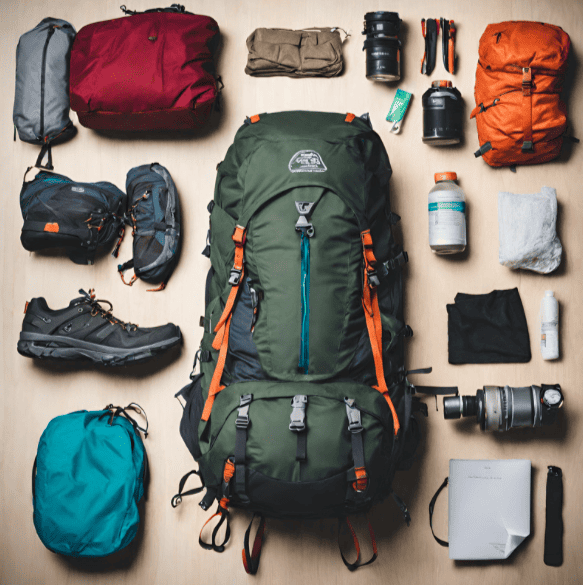
Hey there fellow adventurers!
Are you ready to unlock the backpacker’s secret to a successful 5-day backpacking trip?
Well, hold onto your hiking boots because I’ve got the ultimate packing list that will blow your mind!
From must-have essentials to space-saving strategies, I’ve got you covered.
So get ready to hit the trail with confidence and make your backpacking dreams come true.
Let’s dive in and discover the secrets to a truly epic adventure!
KEY TAKEAWAY
What essentials should be included in a packing list for a 5-day backpacking trip?
When preparing for a 5-day backpacking adventure, it’s crucial to pack efficiently, focusing on lightweight and versatile gear. Essentials include a sturdy backpack, appropriate clothing layers, compact cooking equipment, ample food supplies, a reliable navigation system, and safety items like a first-aid kit and water purification tools.
The Core 19: Veteran Backpackers Reveal Must-Bring Essentials
I can’t wait to learn about the must-bring essentials from veteran backpackers in The Core 19. As someone who loves backpacking, I know how important it’s to have the right gear and supplies for a successful trip. The packing list for a backpacking trip can make or break your experience, so hearing from those who’ve been there and done that’s invaluable.
When it comes to essentials, veteran backpackers have a wealth of knowledge to share. They know exactly what items are crucial for a comfortable and safe journey. From personal experience, I’ve learned that a sturdy backpack, a reliable tent, and a quality sleeping bag are at the top of the list. These items provide the foundation for a successful trip, ensuring that you have a comfortable place to sleep and carry all your gear.
Another essential that veteran backpackers swear by is a good pair of hiking boots. These boots provide support and protection for your feet and ankles, especially when traversing rugged terrain. Along with boots, proper clothing is essential. Layering is key to adjust to changing weather conditions, so pack lightweight, moisture-wicking materials that can be easily added or removed.
In addition to the basics, veteran backpackers often recommend bringing a water filtration system to ensure a clean water source on the trail. They also emphasize the importance of a well-stocked first aid kit, including essentials like bandages, antiseptic wipes, and pain relievers.
Learning from veteran backpackers is like having a treasure trove of knowledge at your fingertips. They’ve experienced the highs and lows of backpacking and can offer invaluable advice on what to bring and what to leave behind. So if you’re planning a backpacking trip, take heed of the advice from the seasoned experts in The Core 19 and pack your essentials wisely.
Demystifying Options: A Practical Guide to Popular Packing Debates
Packing for a backpacking trip can be overwhelming, but demystifying options in a practical guide helps me navigate popular packing debates and make informed choices.
When it comes to preparing for a hiking trip, having an organized packing list is essential. It ensures that I’ve all the necessary items to stay safe and comfortable during my adventure.
One of the most debated topics in backpacking is the number of essential items to bring. Some argue that minimalist packing is the way to go, while others prefer to be fully prepared for any situation. Finding a balance between these two approaches is key. By carefully considering my destination, weather conditions, and personal preferences, I can create a packing list that meets my needs without weighing me down.
Gear lists are another hot topic among backpackers. From choosing the right backpack to selecting the best tent and sleeping bag, the options can be overwhelming. Researching and reading reviews from experienced backpackers can provide valuable insights and help me make informed decisions. It’s important to invest in quality gear that’s durable and lightweight, as this will make a significant difference during a long hike.
Weather-Proof Prep: Customizing Your List for Coming Conditions
Before heading out on a backpacking trip, it’s important to consider the upcoming weather conditions and customize your packing list accordingly. Weather can greatly impact your hiking experience, so it’s crucial to be prepared for all possibilities.
If rain is in the forecast, make sure to pack a waterproof jacket, pants, and a cover for your backpack. Additionally, bring a pair of waterproof hiking boots to keep your feet dry and comfortable.
In cold weather, pack extra layers such as thermal underwear, fleece jackets, and a warm hat and gloves. It’s also important to bring a sturdy tent that can withstand strong winds and keep you protected from the elements.
When it comes to your packing list, always prioritize essentials like food, water, a map, and a first aid kit. Consider the duration of your trip and pack enough supplies to last the entire journey.
Space-Saving Strategies: Tips from the Pros to Pack Efficiently
One of the pros’ top tips for efficient packing is to roll your clothes instead of folding them. Rolling not only saves space in your backpack, but it also helps prevent wrinkles.
Here are five space-saving strategies to help you pack efficiently for your upcoming backpacking trip:
- Multi-purpose items: Choose clothing and gear that can serve multiple functions. For example, a lightweight jacket that can also be used as a pillow or a bandana that can double as a towel.
- Compression sacks: These handy bags allow you to compress your clothes and gear, saving valuable space in your backpack. They’re particularly useful for bulky items like sleeping bags or jackets.
- Organizational pouches: Use small pouches or packing cubes to keep your belongings organized. This not only makes it easier to find what you need, but it also maximizes space by keeping things compact.
- Layering system: Instead of packing bulky sweaters or jackets, opt for a layering system with lightweight, versatile clothing options. This allows you to adjust your clothing based on the weather conditions without taking up too much space in your backpack.
- Minimalist mindset: Prioritize what you truly need and leave behind unnecessary items. Consider the essentials and think about how you can minimize your packing list to only the most important items.
Additional Pastimes Explained: Gear for Specific Activity Add-Ons
I have always been intrigued by the variety of gear options available for different outdoor activities, and the additional pastimes explained in this discussion provide even more opportunities for adventure.
When it comes to outdoor activities like hiking, having the right gear is essential for a safe and enjoyable experience. Hiking boots are a must-have item for any hiker. They provide the necessary support and grip to navigate challenging terrains. Along with hiking boots, rain gear is crucial to keep you dry during unexpected showers. Backpacking essentials such as a sturdy backpack, sleeping bag, and tent are also important for multi-day trips. Trekking poles can be incredibly helpful in providing stability and reducing strain on your joints, especially when tackling steep ascents and descents. Another essential item is a water filter, which allows you to safely drink water from natural sources, eliminating the need to carry heavy water supplies.
With all these gear options, you can customize your outdoor experience to suit your specific activity and preferences.
Now, let’s transition to the next section about sustainable hygiene: ensuring cleanliness on the trail.
Sustainable Hygiene: Ensuring Cleanliness on the Trail
Let’s make sure to pack out all our trash and properly dispose of it to maintain cleanliness on the trail. Keeping the trail clean not only preserves the natural beauty of the surroundings, but also ensures a safe and enjoyable experience for all hikers.
Here are five essential items to help maintain hygiene and cleanliness on the trail:
- Biodegradable soap: Use this to clean your body and dishes while minimizing your impact on the environment.
- Antibacterial wipes: These are handy for quick clean-ups and sanitizing your hands before meals.
- Trash bags: Pack a few extra for collecting and carrying out any waste you generate along the way.
- Extra socks: Keep your feet dry and fresh by changing into clean socks regularly. This helps prevent blisters and keeps odors at bay.
- Hand sanitizer: When water is scarce, this is a must-have for keeping your hands clean and germ-free.
By practicing good hygiene and leaving no trace, we not only contribute to the cleanliness of the trail but also minimize our impact on the delicate ecosystem. Maintaining cleanliness on the trail is just one aspect of ensuring a safe and enjoyable backpacking experience.
Let’s now transition to the next section and discuss the importance of being safety stocked to protect our health in the remote backcountry.
Safety Stocked: Protecting Your Health in the Remote Backcountry
Having a sufficient supply of emergency medical items is essential for protecting my health in the remote backcountry. When venturing into the wilderness, I always make sure to pack a well-stocked first aid kit. This kit includes bandages, antiseptic wipes, painkillers, and other essential items to treat minor injuries that may occur during my backpacking trip.
In addition to the first aid kit, I also bring along a water filter or purification tablets to ensure that I’ve access to clean drinking water. Staying hydrated is crucial for maintaining good health in the backcountry, and having a reliable method for purifying water is vital.
When it comes to food, I pack lightweight, nutrient-dense options that provide me with the energy I need for long days on the trail. I also bring extra food in case of emergencies or unforeseen circumstances that may prolong my time in the wilderness.
Lastly, I make sure to have adequate protection from the elements. This includes a sturdy tent, warm sleeping bag, and appropriate clothing for different weather conditions.
Conclusion
In the vast wilderness, your backpack becomes your sanctuary. As you venture into the backcountry, don’t forget to pack the essentials that will keep you safe, comfortable, and in awe of nature’s grandeur.
From the veteran backpackers’ must-haves to space-saving strategies and sustainable hygiene practices, this packing list has got you covered.
So, grab your gear, embark on an adventure, and let your backpack become a trusted companion on your journey through the untamed beauty of the great outdoors.
Was this helpful?

I’m Robert C. L., an associate professor of management at Washington & Jefferson College. With a Ph.D. in industrial/organizational psychology from The Ohio State University, my passion lies in exploring the realms of creativity, innovation, and the evolving landscape of work. Delving into the digital frontier, my expertise extends to the world of digital nomads, remote work, and the liberating concept of travel freedom. I’m also an author of the book “Digital Nomads: In Search of Freedom, Community, and Meaningful Work in the New Economy” which is sold on Amazon. As a dedicated mind behind timecurvesoft.com, I’m committed to unraveling the dynamics of the digital workforce and sharing insights into the future of work. Join me on this journey of exploration and discovery!